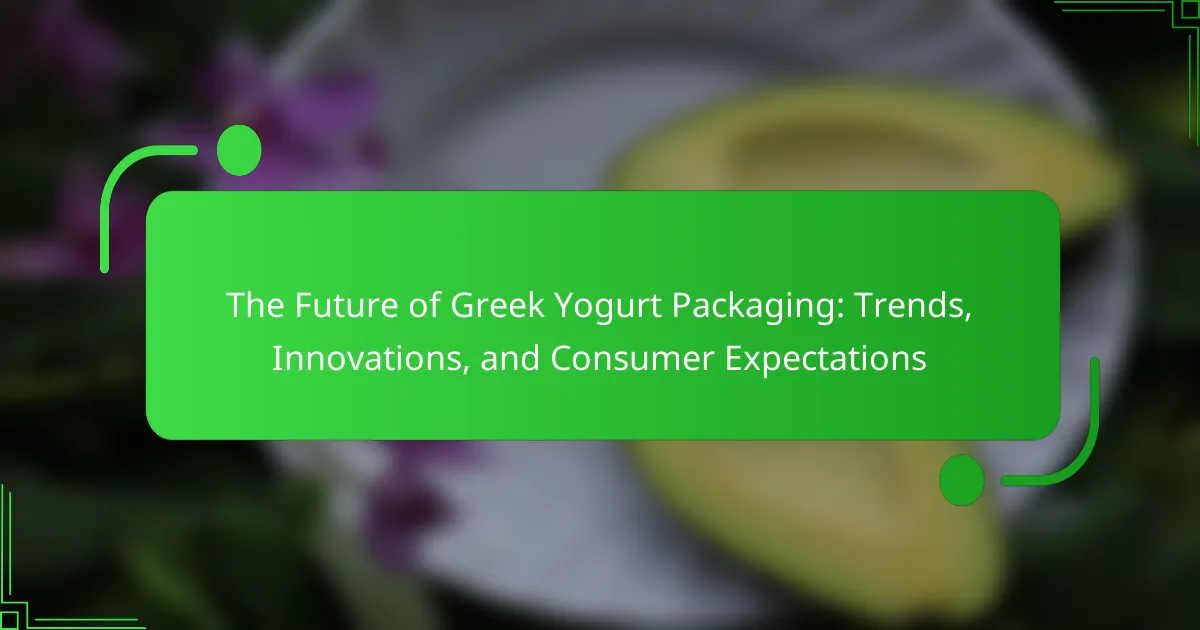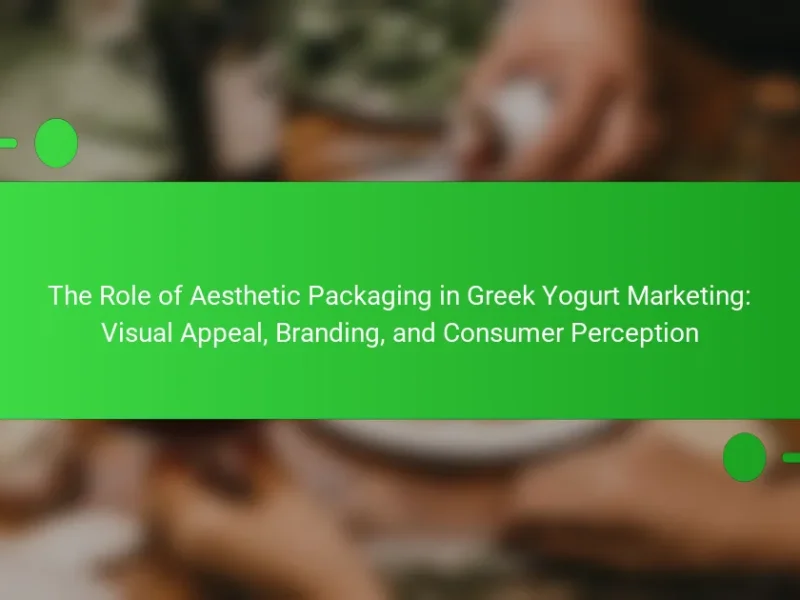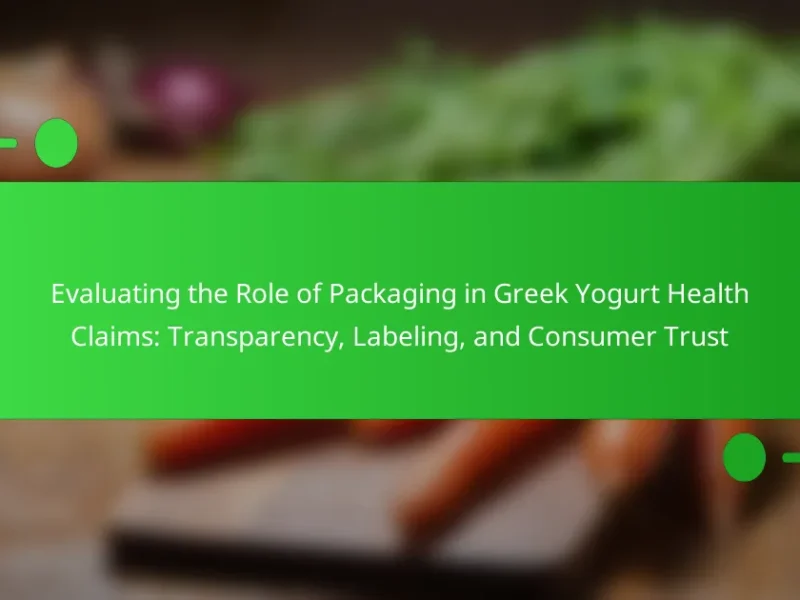The article explores the evolving landscape of Greek yogurt packaging, focusing on current trends, innovations, and consumer expectations. Key trends include the use of sustainable materials, the rise of single-serve formats for convenience, and resealable designs that enhance product freshness. Consumer preferences for transparency, sustainability, and visual appeal significantly influence packaging decisions. The article also addresses challenges faced by manufacturers, such as maintaining product freshness, meeting sustainability demands, ensuring compliance with regulations, and navigating logistics. Overall, it highlights the need for brands to align their packaging strategies with the values and expectations of modern consumers.
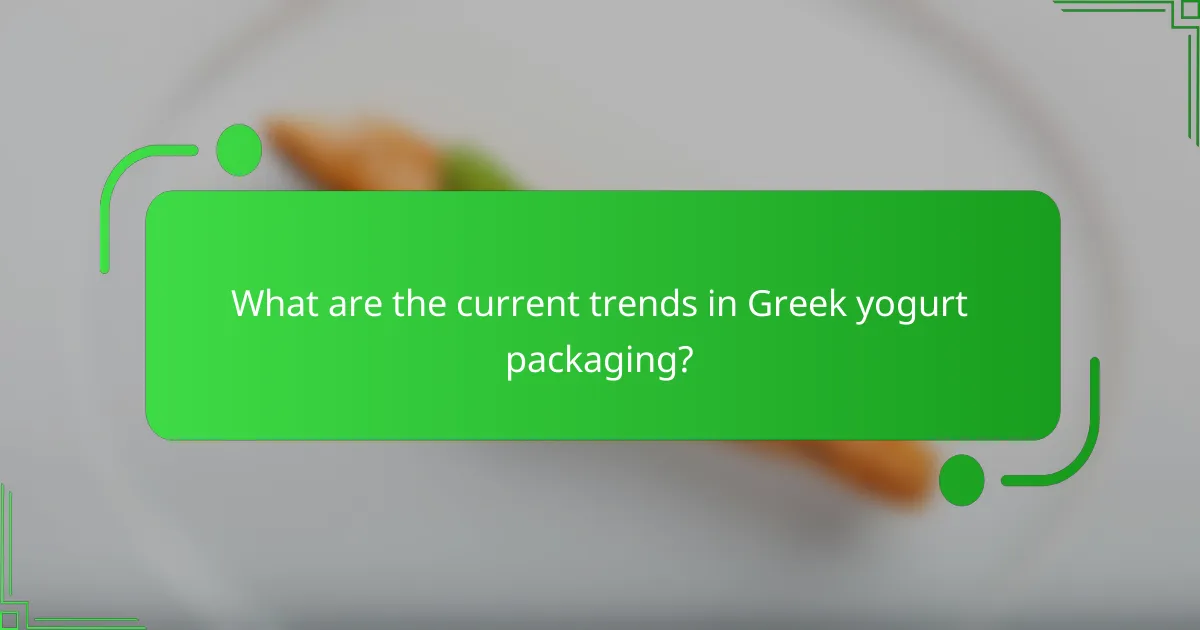
What are the current trends in Greek yogurt packaging?
Current trends in Greek yogurt packaging include sustainable materials, single-serve formats, and resealable designs. Brands are increasingly using biodegradable and recyclable materials to appeal to eco-conscious consumers. Single-serve packaging is gaining popularity due to its convenience for on-the-go consumption. Resealable containers are also trending, as they enhance product freshness and usability. Additionally, innovative designs that showcase product quality and health benefits are being adopted. These trends reflect consumer preferences for convenience, sustainability, and quality in food packaging.
How are consumer preferences influencing packaging designs?
Consumer preferences are significantly shaping packaging designs in the Greek yogurt market. Increasing demand for sustainability drives brands to adopt eco-friendly materials. Consumers favor packaging that is recyclable or biodegradable. Additionally, convenience influences design choices, leading to single-serve and easy-to-open formats. Transparency in labeling is also crucial, as consumers seek clear ingredient information. A study by Mintel found that 56% of consumers prefer brands that use minimal packaging. Furthermore, aesthetic appeal plays a role, with vibrant designs attracting health-conscious buyers. Overall, packaging designs are evolving to align with consumer values and expectations.
What materials are becoming popular for Greek yogurt packaging?
Biodegradable materials are becoming popular for Greek yogurt packaging. These materials include plant-based plastics and compostable films. They cater to the increasing consumer demand for sustainable options. Recyclable materials are also gaining traction, such as PET and paperboard. These options are favored for their lower environmental impact. Innovations in packaging technology enhance the barrier properties of these materials. This ensures product freshness while maintaining sustainability. Studies show that consumers prefer brands with eco-friendly packaging. This trend is reshaping the Greek yogurt market.
How does sustainability impact packaging choices?
Sustainability significantly impacts packaging choices by driving a shift towards eco-friendly materials. Brands prioritize biodegradable, recyclable, or reusable packaging to reduce environmental footprints. This aligns with consumer demand for sustainable products. A 2021 survey found that 74% of consumers are willing to pay more for sustainable packaging. Companies also face regulatory pressures to minimize plastic waste. Innovations in plant-based materials are emerging as viable alternatives. These choices not only enhance brand image but also contribute to long-term sustainability goals.
What innovations are emerging in Greek yogurt packaging?
Innovations in Greek yogurt packaging include eco-friendly materials and portion-controlled designs. Brands are increasingly using biodegradable and recyclable materials to reduce environmental impact. Smart packaging technology is also emerging, allowing consumers to track freshness. Interactive labels are being developed to engage consumers with nutritional information. Additionally, resealable containers are becoming popular for convenience. Innovations aim to enhance user experience while promoting sustainability. These trends align with growing consumer demand for environmentally responsible products.
How are technology and smart packaging changing the landscape?
Technology and smart packaging are transforming the landscape of product delivery and consumer interaction. Smart packaging incorporates features like QR codes and NFC technology. These features allow consumers to access product information easily. Enhanced tracking capabilities improve supply chain transparency. This technology helps in monitoring freshness and reducing food waste. According to a report by Smithers Pira, the smart packaging market is projected to reach $37 billion by 2024. Innovations in materials enhance sustainability and recyclability. This shift meets growing consumer demand for environmentally friendly options. Overall, technology and smart packaging are redefining consumer engagement and operational efficiency in the market.
What role does convenience play in packaging innovations?
Convenience plays a crucial role in packaging innovations by enhancing user experience and accessibility. Innovative packaging designs prioritize ease of use, allowing consumers to open, reseal, and transport products effortlessly. For example, single-serve containers for Greek yogurt cater to on-the-go lifestyles. This convenience aligns with consumer preferences for quick and hassle-free consumption. Research indicates that 70% of consumers prefer packaging that simplifies their daily routines. Therefore, convenience-driven innovations can significantly influence purchasing decisions and brand loyalty in the competitive yogurt market.
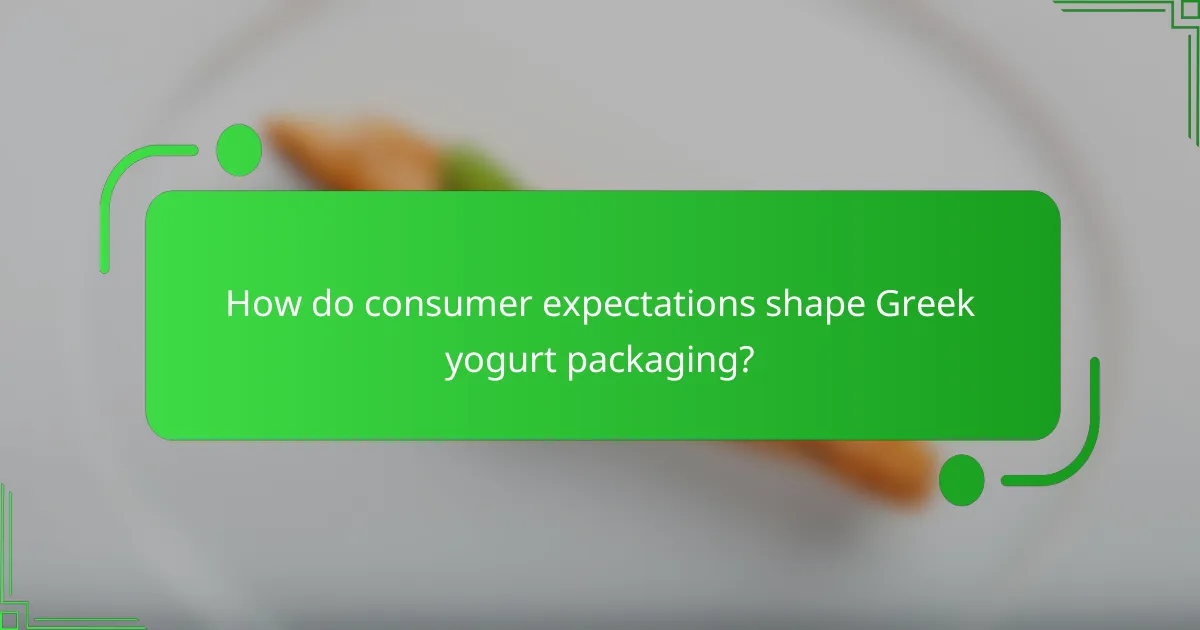
How do consumer expectations shape Greek yogurt packaging?
Consumer expectations significantly influence Greek yogurt packaging design and features. Consumers prioritize convenience, leading to single-serving sizes and resealable containers. They also seek transparency, prompting brands to use clear labeling and ingredient lists. Sustainability is a growing expectation, driving the use of recyclable materials and eco-friendly packaging. Additionally, visual appeal is crucial; attractive designs and vibrant colors attract consumer attention on shelves. Research indicates that 70% of consumers consider packaging when making purchase decisions. These trends reflect the need for brands to align packaging with consumer values and preferences.
What are the key factors consumers consider when choosing yogurt packaging?
Consumers consider several key factors when choosing yogurt packaging. These factors include convenience, sustainability, and product visibility. Convenience refers to the ease of opening and resealing the packaging. Sustainable packaging options are increasingly important, with many consumers preferring recyclable or biodegradable materials. Product visibility allows consumers to see the yogurt’s texture and color, influencing their purchase decision. Additionally, portion size and branding play significant roles in consumer preferences. Research indicates that 74% of consumers are influenced by packaging design when making food purchases.
How does branding affect consumer perceptions of Greek yogurt packaging?
Branding significantly influences consumer perceptions of Greek yogurt packaging. Strong branding can create positive associations with quality and health benefits. Consumers often rely on recognizable brands when making purchasing decisions. Research shows that packaging design elements, like color and typography, reinforce brand identity. For example, a study by Ares et al. (2010) found that appealing packaging increases perceived product value. Additionally, branding can differentiate products in a crowded market. Effective branding leads to higher consumer trust and loyalty. Therefore, branding shapes how consumers interpret the quality and desirability of Greek yogurt packaging.
What are consumers’ views on eco-friendly packaging alternatives?
Consumers generally view eco-friendly packaging alternatives positively. A survey by Nielsen indicates that 66% of global consumers are willing to pay more for sustainable brands. This trend is particularly strong among younger demographics. Many consumers associate eco-friendly packaging with higher quality and social responsibility. Additionally, they express concerns over plastic waste and environmental impact. Research shows that brands using sustainable packaging can enhance customer loyalty. The demand for eco-conscious options continues to grow, influencing purchasing decisions.
How do packaging designs impact the buying decision?
Packaging designs significantly impact buying decisions by influencing consumer perceptions and emotions. Attractive packaging can capture attention and convey brand identity. Research indicates that 72% of consumers judge products by their packaging. Unique shapes and colors can enhance shelf appeal and differentiate products. Functional designs improve usability, leading to a positive experience. A study published in the Journal of Consumer Research found that eco-friendly packaging increases purchase intent. Therefore, effective packaging can drive sales and foster brand loyalty.
What visual elements attract consumers to Greek yogurt products?
Visual elements that attract consumers to Greek yogurt products include vibrant colors, appealing packaging design, and clear labeling. Bright colors can create an eye-catching shelf presence. Attractive packaging shapes, such as unique containers, enhance product appeal. Clear labeling that highlights health benefits and ingredients fosters consumer trust. Research indicates that 70% of purchasing decisions are made at the shelf, emphasizing the importance of visual elements. Additionally, images of fresh ingredients can evoke a sense of quality and freshness. Overall, these visual elements significantly influence consumer choices in the Greek yogurt market.
How does packaging functionality influence purchase behavior?
Packaging functionality significantly influences purchase behavior by affecting product accessibility and convenience. Functional packaging designs, such as resealable tops and portion control, enhance user experience. Research indicates that 62% of consumers consider packaging convenience a purchasing factor. Effective packaging can also communicate product quality and brand values, which can sway consumer decisions. For example, sustainable packaging has been shown to attract eco-conscious buyers. Additionally, visually appealing packaging can increase shelf impact, leading to higher sales. Thus, the functionality of packaging plays a crucial role in shaping consumer preferences and driving purchase decisions.
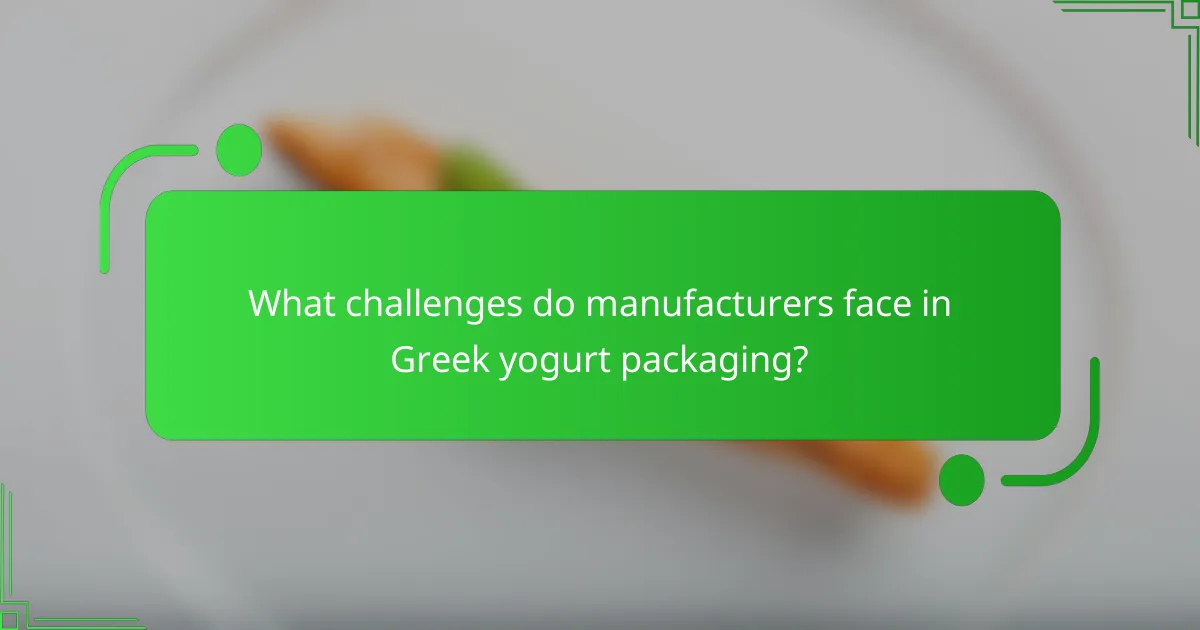
What challenges do manufacturers face in Greek yogurt packaging?
Manufacturers face several challenges in Greek yogurt packaging. One significant challenge is maintaining product freshness and shelf life. Greek yogurt is perishable, requiring packaging that effectively seals in moisture and prevents spoilage.
Another challenge is sustainability. Consumers increasingly demand eco-friendly packaging solutions. Manufacturers must balance sustainability with cost-effectiveness and product protection.
Additionally, branding and differentiation pose challenges. The Greek yogurt market is highly competitive. Unique packaging designs are essential to attract consumers.
Regulatory compliance is also a concern. Packaging must meet food safety standards and labeling requirements. This can complicate the design and production process.
Finally, logistics and distribution issues arise. Packaging must be durable enough to withstand transportation without compromising product integrity. These challenges require innovative solutions and strategic planning.
How do regulations affect packaging choices for Greek yogurt?
Regulations significantly influence packaging choices for Greek yogurt. They dictate material safety, labeling requirements, and environmental standards. For instance, the FDA mandates specific nutritional labeling on yogurt containers. This ensures consumers have accurate information about ingredients and health benefits. Additionally, regulations may promote the use of recyclable materials. This aligns with sustainability goals and consumer preferences for eco-friendly packaging. Compliance with these regulations can affect production costs and design decisions. Companies must balance regulatory requirements with market trends to remain competitive.
What are the common logistical issues in packaging Greek yogurt?
Common logistical issues in packaging Greek yogurt include temperature control, shelf life, and packaging integrity. Greek yogurt requires cold chain management to maintain quality. Any temperature fluctuations can lead to spoilage. Additionally, the shelf life of Greek yogurt is often shorter than that of regular yogurt. This necessitates efficient distribution to reduce waste. Packaging integrity is crucial to prevent leaks and contamination. Improper sealing can result in product loss during transport. These factors collectively challenge the efficiency of the supply chain in Greek yogurt packaging.
What strategies can manufacturers adopt to meet consumer expectations?
Manufacturers can adopt several strategies to meet consumer expectations in Greek yogurt packaging. First, they should prioritize sustainable packaging materials. Research shows that 74% of consumers prefer brands that use eco-friendly packaging. Second, manufacturers can enhance product visibility with transparent or clear packaging. This allows consumers to see the product quality before purchase. Third, they can innovate with resealable packaging to improve convenience. Studies indicate that 60% of consumers value convenience in product usage. Fourth, manufacturers should focus on informative labeling. Clear nutritional information and ingredient lists help consumers make informed choices. Finally, engaging with consumers through feedback can guide packaging improvements. This responsiveness can increase brand loyalty and trust.
How can manufacturers balance innovation with cost-effectiveness?
Manufacturers can balance innovation with cost-effectiveness by adopting lean manufacturing principles. Lean manufacturing minimizes waste while maximizing productivity. This approach allows for the development of innovative packaging solutions without incurring excessive costs.
Additionally, manufacturers can invest in technology that enhances efficiency. For example, automation in packaging processes can reduce labor costs and improve speed. A study by the International Journal of Production Economics found that automation can lead to a 30% reduction in production costs.
Collaboration with suppliers can also drive innovation while keeping costs in check. By working closely with suppliers, manufacturers can source materials that are both innovative and cost-effective. This strategy can lead to the development of sustainable packaging options that appeal to consumers.
Finally, conducting market research can help manufacturers identify consumer preferences. Understanding these preferences allows for targeted innovation that meets market demand without overspending. Research by Nielsen indicates that 66% of consumers are willing to pay more for sustainable packaging, highlighting the importance of aligning innovation with consumer expectations.
What best practices should be followed for effective Greek yogurt packaging?
Effective Greek yogurt packaging should prioritize freshness, convenience, and sustainability. Freshness can be maintained through airtight seals and moisture barriers. Convenience is enhanced with easy-to-open lids and portion control designs. Sustainability is achieved by using recyclable materials and minimizing plastic use. Clear labeling of nutritional information and ingredients is essential for consumer trust. Additionally, attractive design can influence purchasing decisions. Research indicates that consumers prefer packaging that reflects quality and care in production.
The main entity of the article is Greek yogurt packaging. The article examines current trends in packaging, highlighting the shift towards sustainable materials, single-serve formats, and resealable designs that meet consumer preferences for convenience and eco-friendliness. It discusses how consumer expectations shape packaging choices, emphasizing the importance of transparency, visual appeal, and functionality. Additionally, the article addresses challenges manufacturers face, such as maintaining product freshness and navigating regulations, while outlining strategies for balancing innovation with cost-effectiveness in packaging design.
